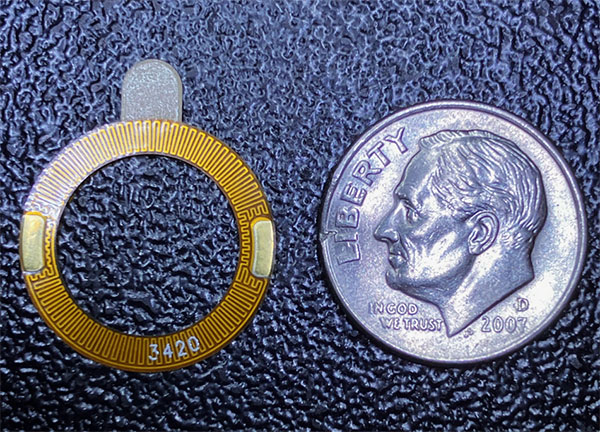Copper vs. CuNi for Flexible Heater Elements
Voltage, heater size and material costs all factor into the decision process.
 I would like to use a flexible heater in a product I am designing, but I am concerned about cost. Flexible heaters typically seem a lot more expensive than regular (copper) flexible circuits. What is the advantage to using a resistive metal? Why not just use copper for all flexible heaters?
I would like to use a flexible heater in a product I am designing, but I am concerned about cost. Flexible heaters typically seem a lot more expensive than regular (copper) flexible circuits. What is the advantage to using a resistive metal? Why not just use copper for all flexible heaters?
Copper can certainly be used for the heating element material in a flexible heater in many applications. When a design permits copper to be used for the heater, that will usually be the most cost-effective way to go. But how do you know if copper is a good choice for an application?
Cost impacts of copper heating element. The first hurdle to clear to ensure copper is a good cost-effective solution for a heater is the electrical resistance requirement. The biggest problem with using copper as the heating element is that it has very low coefficient of resistance. To get any appreciable resistance in the heating area, very thin copper must be used and element traces made very narrow in order to pack as many lineal inches into the heating area as possible. Both these will work against your goal of reducing costs. Also, base laminates that are clad with less than 0.5oz copper thickness are typically more expensive due to their fragile nature, and industry use of materials this thin is far less than use of 0.5oz or 1oz copper thicknesses. Another drawback of narrow traces is that the manufacturer's yields will be less optimal, which in turn equates to a higher selling price of the end-product. Another downside to incorporating very narrow traces that many designers fail to take into account is the trace width variations from part to part due to etch tolerances.
The amount of trace width variation is based on the metal thickness, printing variations, etch strength variations, etc., but typically runs +/-0.001″ to +/-0.002″ on thinner foils (0.5oz or less). This trace width variation has a direct impact on the resistance of the heater. As an example, if the design trace width is 0.020″ and the trace width tolerance is +/-0.001″, the resistance tolerance based on only that variable would be +/-5%. Unfortunately, unless the heater is really big, the copper traces will most likely be in the 0.005″-0.006″ range (or less). In that case, the same trace width tolerance equates to +/-17-20%. Additional processing variables will impact resistance tolerance, so most manufacturers want +/-20-25% on the drawing to have respectable yields. Can your system tolerate and function with that amount of variation?
Another drawback to using copper for the heating element is that the resistance changes with temperature. If operating over a very small temperature range, the change in resistance due to temperature may be inconsequential. Over a large temperature range, however, the TCR can make it much more difficult to control the heater. The additional electronics necessary to accurately monitor the temperature and then drive a changing resistance load to maintain desired temp will drive up controller cost.
Cost impacts of using a copper-nickel alloy heating element. While several common resistive foils are used to make flexible heaters, I will only discuss copper nickel alloys such as Constantan or CuNi 715. Due to their moderate coefficient of resistances, these are really the only alternatives that could potentially be built using either copper or a CuNi alloy. The biggest drawback to using a CuNi alloy for a flexible heater is raw material cost. The cost of the bare metal foil can be two to three times that of a copper-clad laminate, and will require the fabricator to then laminate a dielectric film to one side of the foil prior to the photoetching processes. All said and done, the cost to get the material to the metal-clad laminate stage will be three to four times more expensive than just purchasing a copper-clad laminate. Projects with a CuNi alloy will unequivocally start in the hole cost-wise, but paybacks can offset some – if not all – of the additional cost of the raw materials. The higher resistivity of CuNi alloys will permit much wider traces to achieve elevated resistance values. Additionally, the wider traces will result in much better etch yields and much tighter resistance tolerances. These mean better overall yields for the fabricator, which will lower the selling cost. As a bonus, CuNi alloys have a very flat TCR, making the heaters easier to control.
How do you decide? As a rule of thumb, the smaller the heater, the closer the prices will be between copper and CuNi. Very large heaters (one to four pieces per processing panel) will be significantly more expensive when built using CuNi. On smaller parts where there are 15 to 20 pieces or more per panel, the material cost has a much smaller impact and CuNi becomes very attractive for the reasons stated above. For heaters that fall between these limits, CuNi will still probably be a little more expensive, but the tighter tolerances and the improved performance of CuNi may well override the added expense.
Due to the greater resistance of CuNi alloys, a lot more resistance can be packed into a much smaller area than with copper. If the heater is very small, or has higher voltage, you may have to go this direction out of necessity (FIGURE 1).

Figure 1. Thin resistive CuNi alloys permit much higher resistance density than copper.
Still in doubt about which way to go with your specific application? Have a chat with your fabricator. Having seen hundreds of different flexible heater designs, they should be able to quantify the cost versus value tradeoff to help make the best-informed decision.
is senior application engineer at Flexible Circuit Technologies (flexiblecircuit.com); This email address is being protected from spambots. You need JavaScript enabled to view it.. He and co-"Flexpert" (This email address is being protected from spambots. You need JavaScript enabled to view it.) welcome your suggestions. Finstad and Koop will speak at the PCB West technical conference in September in the Santa Clara (CA) Convention Center.




